Dry season grazing in cropland [Benin]
- Creation:
- Update:
- Compiler: Gatien AGBOKOUN CHRISTOPHE
- Editors: Siagbé Golli, Abdoul Karim MIEN, DOSSOU-YOVO bernardin, Bona Ibouratou DAFIA, Oscar Assa KINDEMIN, Tabitha Nekesa, Ahmadou Gaye
- Reviewers: Sally Bunning, Rima Mekdaschi Studer, William Critchley
technologies_6536 - Benin
View sections
Expand all Collapse all1. General information
1.2 Contact details of resource persons and institutions involved in the assessment and documentation of the Technology
Key resource person(s)
land user:
MADE Sambo
CERABE ONG
Benin
SLM specialist:
BONI Mouhamadou
CERABE ONG
Benin
SLM specialist:
LAFIA BAWA Abdel-Aziz
CERABE ONG
Benin
Name of project which facilitated the documentation/ evaluation of the Technology (if relevant)
Soil protection and rehabilitation for food security (ProSo(i)l)Name of the institution(s) which facilitated the documentation/ evaluation of the Technology (if relevant)
World Overview of Conservation Approaches and Technologies (WOCAT)1.3 Conditions regarding the use of data documented through WOCAT
The compiler and key resource person(s) accept the conditions regarding the use of data documented through WOCAT:
Yes
1.4 Declaration on sustainability of the described Technology
Is the Technology described here problematic with regard to land degradation, so that it cannot be declared a sustainable land management technology?
No
2. Description of the SLM Technology
2.1 Short description of the Technology
Definition of the Technology:
Rotational livestock grazing is an integrated agriculture and livestock management system where livestock are grazed in the dry season, in a crop field, to feed on crop residues and/or weeds and where manure is used as an organic fertiliser for soil restoration purposes. While grazing, the animals feed on crop residues (millet or maize stalks) or, sometimes on Gliricidia sepium leaves.
2.2 Detailed description of the Technology
Description:
Livestock grazing, typically with the "Borgou" breed, takes place in the dry season in crop fields dedicated to food production (maize, millet) or cash crops (soy and cotton). This practice involves overnight confinement of the animals which are individually tethered with ropes and stakes.
To effectively deploy this technology, oxen are restrained from late afternoon to early morning in a field, during the dry season, to utilize their manure directly as organic fertilizer. The entire heard is transferred from one plot to another or within the same plot, at varying intervals, ranging from a few days to a maximum of two weeks, to distribute the manure. This grazing technique is the preferred method employed during the dry season for fertilizing cereal fields by farmers who have livestock or can borrow animals. For farmers, the advantage of this grazing approach lies in the fact that the animals themselves transfer the fertilizer with minimal investment (ropes, stakes, etc.). All animal droppings, including faeces and urine, are deposited on the land during the 14 hours they typically spend there during a day. In these conditions, the quantities of faeces deposited amount to approximately 50 kg of dry matter per Tropical Livestock Unit (TLU) per month. With faeces and urine emissions evenly distributed over several hours, animals' droppings are dispersed over the grazing land depending on the amount of time they spend there, the rest being concentrated in resting areas, night paddocks and watering places (streams).
Grazing takes place between January and April. The animals are removed from the fields as soon as the first rains fall, to start preparing the soil for planting crops.
Farmers without animals of their own request livestock from other farmers, offering to feed them in exchange for their use during the grazing period. To ensure the animals are adequately fed during this period, some farmers plant Gliricidia trees on their farms. These fast-growing leguminous fodder trees not only serve as a source of food for the animals but also contribute to stabilizing and restoring the soil through nitrogen fixation.
2.3 Photos of the Technology
2.5 Country/ region/ locations where the Technology has been applied and which are covered by this assessment
Country:
Benin
Region/ State/ Province:
Alibori
Further specification of location:
Gogounou
Specify the spread of the Technology:
- applied at specific points/ concentrated on a small area
Is/are the technology site(s) located in a permanently protected area?
No
Comments:
These cultivated areas serve as post-harvest grazing grounds for animals. The study area boasts the highest concentration of livestock farmers in Benin. Unfortunately, the potential inherent in this livestock has not been fully harnessed. The introduction of GIZ's ProSOL program brought about increased awareness among farmers regarding the advantages of coexisting with livestock breeders. Consequently, negotiations ensued between farmers and breeders, resulting in agreements for the latter's animals to graze on the farmers' farmland.
Map
×2.6 Date of implementation
If precise year is not known, indicate approximate date:
- 10-50 years ago
2.7 Introduction of the Technology
Specify how the Technology was introduced:
- through projects/ external interventions
Comments (type of project, etc.):
Thanks to the efforts of ProSOL, the system has been embraced even by farmers without livestock ownership. For those with livestock, adopting the system has become a spontaneous habit.
3. Classification of the SLM Technology
3.1 Main purpose(s) of the Technology
- improve production
- reduce, prevent, restore land degradation
- preserve/ improve biodiversity
- create beneficial economic impact
3.2 Current land use type(s) where the Technology is applied
Land use mixed within the same land unit:
Yes
Specify mixed land use (crops/ grazing/ trees):
- Agro-pastoralism (incl. integrated crop-livestock)

Cropland
- Annual cropping
Annual cropping - Specify crops:
- cereals - maize
- cereals - millet
Number of growing seasons per year:
- 1
Is intercropping practiced?
No
Is crop rotation practiced?
Yes
If yes, specify:
Maize and cotton

Grazing land
Extensive grazing:
- Ranching
Animal type:
- cattle - non-dairy beef
Is integrated crop-livestock management practiced?
Yes
If yes, specify:
By confining their animals to these lands, farmers aim to harness the potential for crop fertilization provided by the animals' manure.
Products and services:
- manure as fertilizer/ energy production
Species:
cattle - non-dairy beef
Count:
5000
3.3 Has land use changed due to the implementation of the Technology?
Has land use changed due to the implementation of the Technology?
- Yes (Please fill out the questions below with regard to the land use before implementation of the Technology)
Land use mixed within the same land unit:
Yes
Specify mixed land use (crops/ grazing/ trees):
- Agro-pastoralism (incl. integrated crop-livestock)

Cropland
- Annual cropping
Annual cropping - Specify crops:
- cereals - maize
- cereals - millet
Is intercropping practiced?
No
Is crop rotation practiced?
Yes
If yes, specify:
Cotton, Maize

Grazing land
Extensive grazing:
- Ranching
Animal type:
- cattle - non-dairy beef
Is integrated crop-livestock management practiced?
Yes
If yes, specify:
Animal droppings are used to fertilize arable lands.
Species:
cattle - non-dairy beef
Count:
300
Comments:
As farmers become aware of the importance of having animals at their disposal, they started raising their own. Around 300 head of cattle have now been bred by farmers since the introduction of the system.
3.4 Water supply
Water supply for the land on which the Technology is applied:
- rainfed
3.5 SLM group to which the Technology belongs
- rotational systems (crop rotation, fallows, shifting cultivation)
- integrated crop-livestock management
3.6 SLM measures comprising the Technology

agronomic measures
- A2: Organic matter/ soil fertility
- A3: Soil surface treatment
- A6: Residue management
A6: Specify residue management:
A 6.2: grazed
Comments:
As far as reducing workload is concerned, it is achieved by reducing the amount of externally applied mineral fertilisers, because not only is the quantity of fertiliser reduced, but the amount of work required to spread it also drops considerably.
3.7 Main types of land degradation addressed by the Technology

chemical soil deterioration
- Cn: fertility decline and reduced organic matter content (not caused by erosion)
3.8 Prevention, reduction, or restoration of land degradation
Specify the goal of the Technology with regard to land degradation:
- reduce land degradation
- restore/ rehabilitate severely degraded land
4. Technical specifications, implementation activities, inputs, and costs
4.1 Technical drawing of the Technology
Technical specifications (related to technical drawing):
Cattle are tethered at a distance exceeding 5 meters to prevent the concentration of their excrement and urine in a small area. After being confined to a specific space for a maximum of 14 consecutive nights, the area is vacated, and another section of the plot is occupied. This method is gradually expanded until the entire surface area or an unproductive portion of the plot is covered. The rate at which excrement is relocated and the extent of coverage in a given area depend on the number of cattle heads being grazed. Typically, 4 to 5 cattle are confined to an area of 0.25 hectares. Grazing occurs from January to April, and as the rainy season commences, the cattle are relocated from the fields to initiate soil preparation for cultivation
Author:
ProSOL / GIZ, Picture from the SLM Image Box
Date:
01/19/2023
4.2 General information regarding the calculation of inputs and costs
Specify how costs and inputs were calculated:
- per Technology area
Indicate size and area unit:
1ha
other/ national currency (specify):
CFA F
If relevant, indicate exchange rate from USD to local currency (e.g. 1 USD = 79.9 Brazilian Real): 1 USD =:
615.46
4.3 Establishment activities
| Activity | Timing (season) | |
|---|---|---|
| 1. | Searching for and removing stakes | December to March |
| 2. | Positioning stakes | December to March |
4.4 Costs and inputs needed for establishment
| Specify input | Unit | Quantity | Costs per Unit | Total costs per input | % of costs borne by land users | |
|---|---|---|---|---|---|---|
| Labour | Positioning stakes | Stake | 20.0 | 50.0 | 1000.0 | 100.0 |
| Equipment | Machette | Unit | 1.0 | 3500.0 | 3500.0 | 100.0 |
| Construction material | Stakes | Stakes | 20.0 | 50.0 | 1000.0 | 100.0 |
| Construction material | Ropes | Ropes | 20.0 | 100.0 | 2000.0 | 100.0 |
| Total costs for establishment of the Technology | 7500.0 | |||||
| Total costs for establishment of the Technology in USD | 12.19 | |||||
4.5 Maintenance/ recurrent activities
| Activity | Timing/ frequency | |
|---|---|---|
| 1. | Securing the plot concerned (fencing using millet stalks) | December to April |
| 2. | Installation of firebreaks to protect crop residues | December to April |
4.6 Costs and inputs needed for maintenance/ recurrent activities (per year)
If you are unable to break down the costs in the table above, give an estimation of the total costs of maintaining the Technology:
50000.0
Comments:
Farmers say that these are the two main activities required to sustain the system. However, they have never put it into practice, and any attempt to estimate the requirements for each element would be speculative. Nevertheless, they believe that this could be achieved with a lump sum of CFA F 50,000, but the system has never been put into practice as it has never been deemed an emergency.
4.7 Most important factors affecting the costs
Describe the most determinate factors affecting the costs:
The manpower needed to install the fence
5. Natural and human environment
5.1 Climate
Annual rainfall
- < 250 mm
- 251-500 mm
- 501-750 mm
- 751-1,000 mm
- 1,001-1,500 mm
- 1,501-2,000 mm
- 2,001-3,000 mm
- 3,001-4,000 mm
- > 4,000 mm
Specify average annual rainfall (if known), in mm:
1100.00
Specifications/ comments on rainfall:
The area is characterized by a Sudano-Guinean climate, with a rainy season lasting between May and October and a dry season and Harmattan from November to April.
Agro-climatic zone
- semi-arid
5.2 Topography
Slopes on average:
- flat (0-2%)
- gentle (3-5%)
- moderate (6-10%)
- rolling (11-15%)
- hilly (16-30%)
- steep (31-60%)
- very steep (>60%)
Landforms:
- plateau/plains
- ridges
- mountain slopes
- hill slopes
- footslopes
- valley floors
Altitudinal zone:
- 0-100 m a.s.l.
- 101-500 m a.s.l.
- 501-1,000 m a.s.l.
- 1,001-1,500 m a.s.l.
- 1,501-2,000 m a.s.l.
- 2,001-2,500 m a.s.l.
- 2,501-3,000 m a.s.l.
- 3,001-4,000 m a.s.l.
- > 4,000 m a.s.l.
Indicate if the Technology is specifically applied in:
- not relevant
5.3 Soils
Soil depth on average:
- very shallow (0-20 cm)
- shallow (21-50 cm)
- moderately deep (51-80 cm)
- deep (81-120 cm)
- very deep (> 120 cm)
Soil texture (topsoil):
- coarse/ light (sandy)
- fine/ heavy (clay)
Soil texture (> 20 cm below surface):
- medium (loamy, silty)
Topsoil organic matter:
- low (<1%)
5.4 Water availability and quality
Ground water table:
5-50 m
Availability of surface water:
medium
Water quality (untreated):
good drinking water
Water quality refers to:
ground water
Is water salinity a problem?
No
Is flooding of the area occurring?
No
5.5 Biodiversity
Species diversity:
- medium
Habitat diversity:
- medium
5.6 Characteristics of land users applying the Technology
Sedentary or nomadic:
- Sedentary
Market orientation of production system:
- mixed (subsistence/ commercial)
Off-farm income:
- less than 10% of all income
Relative level of wealth:
- poor
Individuals or groups:
- individual/ household
Level of mechanization:
- animal traction
Gender:
- women
- men
Age of land users:
- youth
- middle-aged
5.7 Average area of land used by land users applying the Technology
- < 0.5 ha
- 0.5-1 ha
- 1-2 ha
- 2-5 ha
- 5-15 ha
- 15-50 ha
- 50-100 ha
- 100-500 ha
- 500-1,000 ha
- 1,000-10,000 ha
- > 10,000 ha
Is this considered small-, medium- or large-scale (referring to local context)?
- small-scale
5.8 Land ownership, land use rights, and water use rights
Land ownership:
- individual, not titled
Land use rights:
- communal (organized)
- individual
Water use rights:
- communal (organized)
Are land use rights based on a traditional legal system?
Yes
Specify:
Land ownership is governed by customary law. Land is passed down from father to son within the same family.
5.9 Access to services and infrastructure
health:
- poor
- moderate
- good
education:
- poor
- moderate
- good
technical assistance:
- poor
- moderate
- good
employment (e.g. off-farm):
- poor
- moderate
- good
markets:
- poor
- moderate
- good
energy:
- poor
- moderate
- good
roads and transport:
- poor
- moderate
- good
drinking water and sanitation:
- poor
- moderate
- good
financial services:
- poor
- moderate
- good
6. Impacts and concluding statements
6.1 On-site impacts the Technology has shown
Socio-economic impacts
Production
crop production
Quantity before SLM:
1700kg
Quantity after SLM:
6800
Comments/ specify:
Producers using the system noticed that their maize yield in the same space doubled during the first year, and as they continued using it, it increased by a factor of 4.
fodder quality
production area
Comments/ specify:
The effectiveness of the system led producers to abandon the practice of cultivating crops over large expanses of land.
land management
Income and costs
expenses on agricultural inputs
farm income
workload
Comments/ specify:
The reduced workload is associated with lower chemical fertiliser transportation activity, which also meant that fertilizer spreading activity dropped.
Socio-cultural impacts
food security/ self-sufficiency
Comments/ specify:
By enhancing harvests, the system empowers farmers to achieve greater self-sufficiency in food production.
health situation
Comments/ specify:
Higher incomes mean improved access to healthcare
SLM/ land degradation knowledge
Comments/ specify:
They easily understood the relevance of combining livestock farming and crop farming. Some producers who did not have animals, judging by their yields, finally started livestock farming and now have livestock they can use to apply the technique on their farms.
conflict mitigation
Comments/ specify:
It is the farmers who ask the breeders to have their cattle grazed on their lands. However, this is done according to precise rules (animals must not be allowed to graze on crop residues beyond those agreed, and grazing ends as soon as the rainy season starts).
Ecological impacts
Soil
soil compaction
Comments/ specify:
The greater the number of cattle in a herd, the greater the compaction of field access paths.
Biodiversity: vegetation, animals
invasive alien species
Comments/ specify:
Animal droppings can occasionally contain sprouts of foreign plants, including species like Euphorbia hirta.
6.2 Off-site impacts the Technology has shown
reliable and stable stream flows in dry season
Comments/ specify:
When animals are brought in for grazing, there is increased pressure on the watercourses near the grazing areas, as these serve as the water sources for the animals during this period.
6.3 Exposure and sensitivity of the Technology to gradual climate change and climate-related extremes/ disasters (as perceived by land users)
Gradual climate change
Gradual climate change
| Season | increase or decrease | How does the Technology cope with it? | |
|---|---|---|---|
| annual temperature | increase | very well | |
| seasonal temperature | dry season | increase | well |
| annual rainfall | decrease | well | |
| seasonal rainfall | wet/ rainy season | decrease | moderately |
Climate-related extremes (disasters)
Climatological disasters
| How does the Technology cope with it? | |
|---|---|
| drought | well |
6.4 Cost-benefit analysis
How do the benefits compare with the establishment costs (from land users’ perspective)?
Short-term returns:
positive
Long-term returns:
very positive
How do the benefits compare with the maintenance/ recurrent costs (from land users' perspective)?
Short-term returns:
very positive
Long-term returns:
very positive
6.5 Adoption of the Technology
- 11-50%
Of all those who have adopted the Technology, how many did so spontaneously, i.e. without receiving any material incentives/ payments?
- 91-100%
6.6 Adaptation
Has the Technology been modified recently to adapt to changing conditions?
No
6.7 Strengths/ advantages/ opportunities of the Technology
| Strengths/ advantages/ opportunities in the land user’s view |
|---|
| Increased crop yields; regeneration of soil fertility; lasting effect (3 to 4 years) in the soil before the new process starts |
| Farmers and livestock breeders live together peacefully |
| Reduced consumption of mineral fertilizers |
| Reduced workload and organic fertiliser transportation requirements |
| Strengths/ advantages/ opportunities in the compiler’s or other key resource person’s view |
|---|
| Increased crop yields |
| Improved soil fertility |
| Farmers and livestock breeders fostering better relations; conflict management |
6.8 Weaknesses/ disadvantages/ risks of the Technology and ways of overcoming them
| Weaknesses/ disadvantages/ risks in the land user’s view | How can they be overcome? |
|---|---|
| Cattle becoming a limiting factor | Negotiating grazing arrangements with Fulani herders |
| Limited grazing surface area | Perform the operation every year, targeting/prioritising infertile areas |
| Weaknesses/ disadvantages/ risks in the compiler’s or other key resource person’s view | How can they be overcome? |
|---|---|
| A lack of animals limits adoption of the technique. | Farmers can start breeding and have their own animals. |
7. References and links
7.1 Methods/ sources of information
- field visits, field surveys
2
- interviews with land users
1
- interviews with SLM specialists/ experts
2
- compilation from reports and other existing documentation
3
When were the data compiled (in the field)?
02/07/2023
7.2 References to available publications
Title, author, year, ISBN:
Deutsche Gesellschaft für Internationale Zusammenarbeit (GIZ) GmbH, 2018, Mesures de Gestion Durable des Terres (GDT) et de l’Adaptation au Changement Climatique (ACC) : Compendium de fiches techniques du formateur
7.3 Links to relevant online information
Title/ description:
Gogounou Communal Development Plan
URL:
https://docplayer.fr/32776888-Plan-de-developpement-de-la-commune-de-gogounou.html
Title/ description:
Monograph on the Commune of Gogounou
URL:
https://www.yumpu.com/fr/document/view/28423274/monographie-de-la-commune-de-bohicon-association-nationale-
Links and modules
Expand all Collapse allLinks
No links
Modules
No modules






